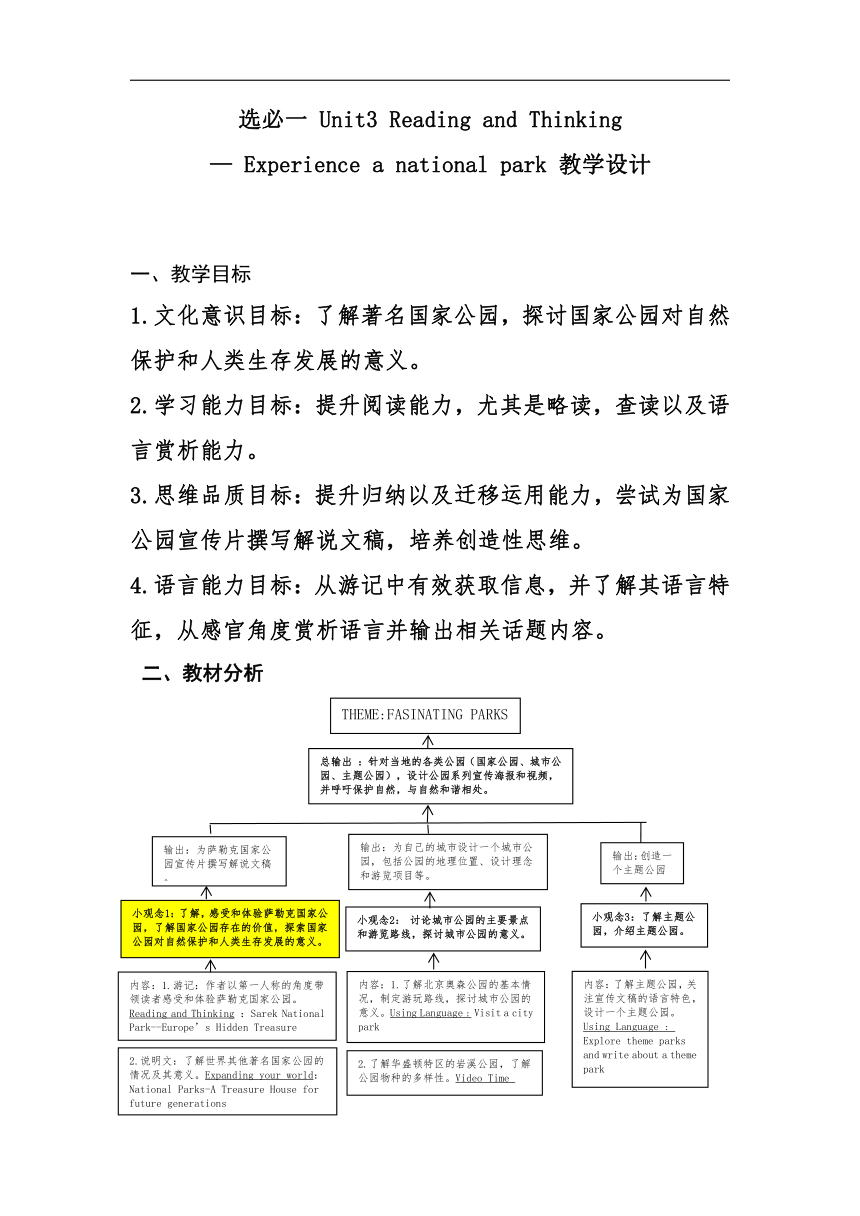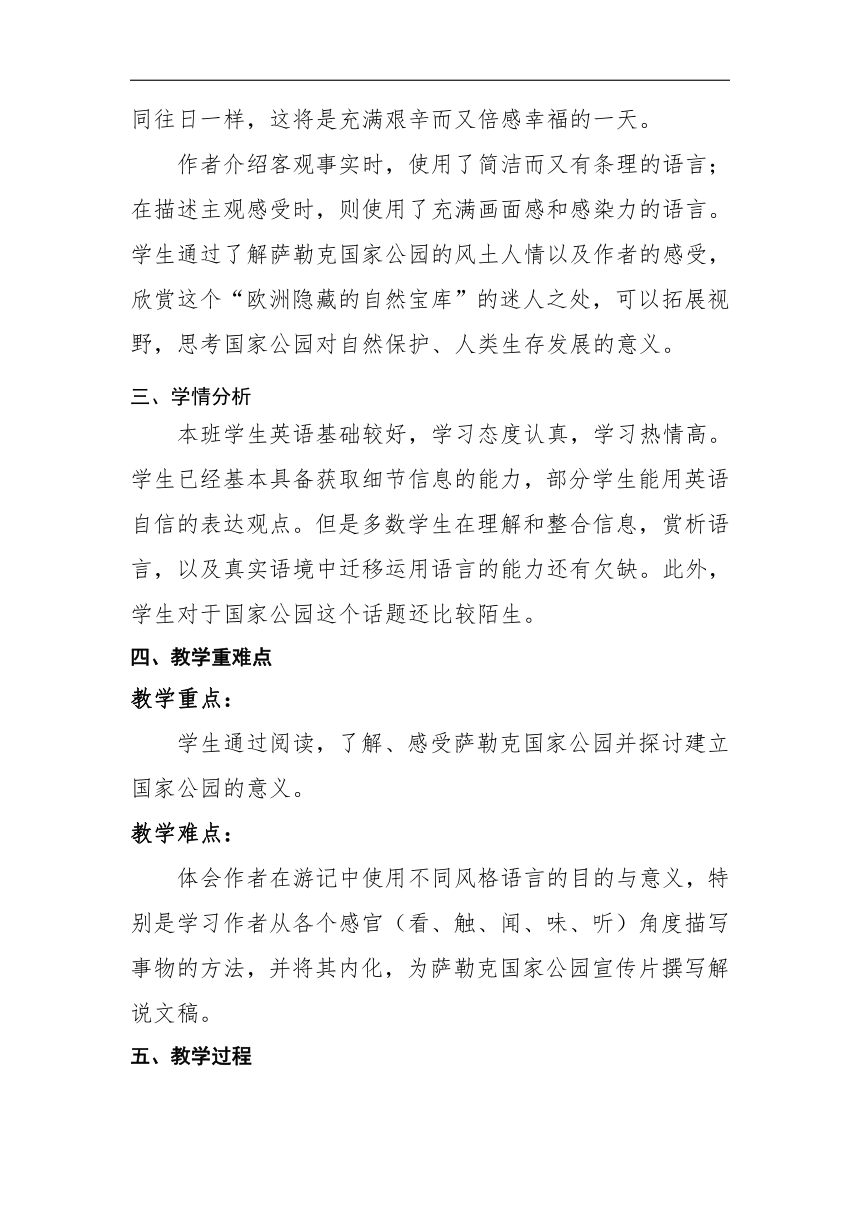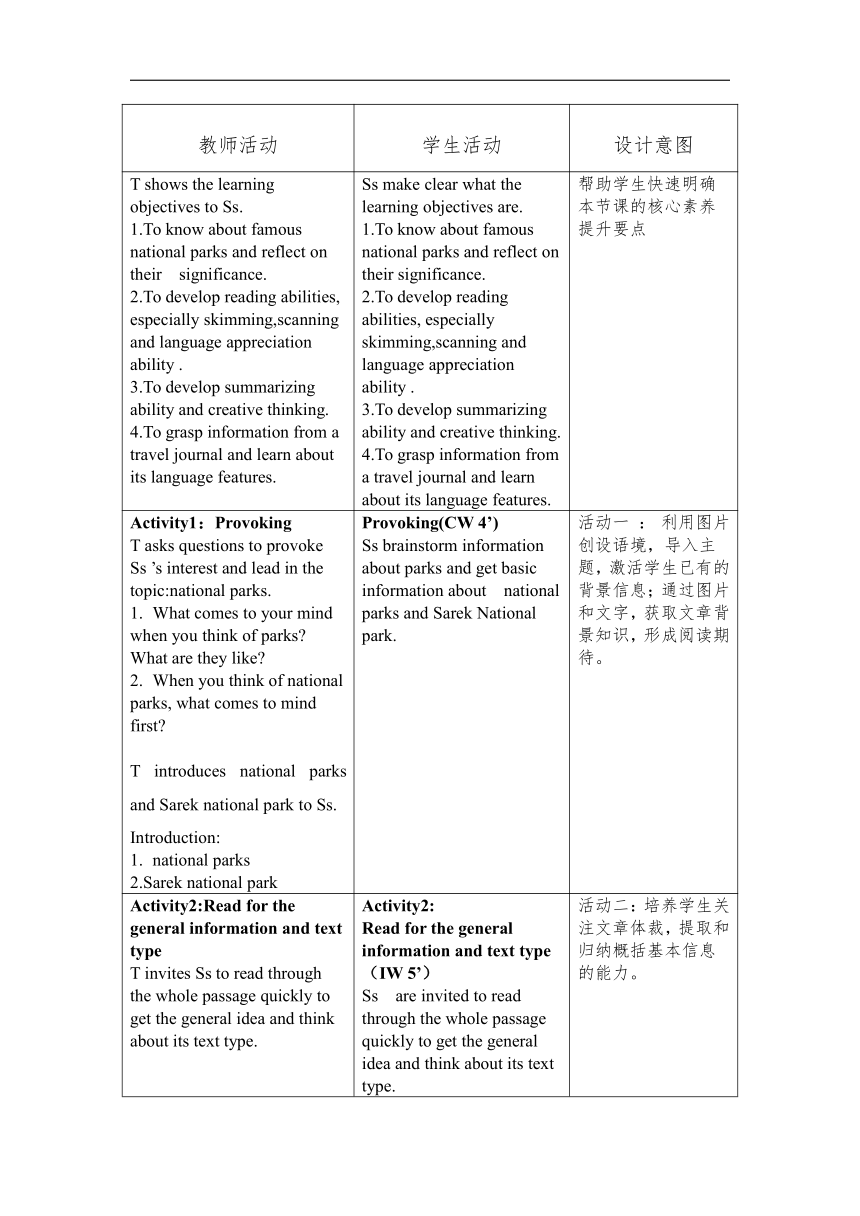Unit 3 Fascinating Parks Reading and Thinking 教学设计-2024-2025学年高中英语人教版(2019)选择性必修第一册
文档属性
| 名称 | Unit 3 Fascinating Parks Reading and Thinking 教学设计-2024-2025学年高中英语人教版(2019)选择性必修第一册 |  | |
| 格式 | docx | ||
| 文件大小 | 49.4KB | ||
| 资源类型 | 教案 | ||
| 版本资源 | 人教版(2019) | ||
| 科目 | 英语 | ||
| 更新时间 | 2025-01-21 11:03:47 | ||
图片预览




文档简介
选必一 Unit3 Reading and Thinking
— Experience a national park 教学设计
教学目标
1.文化意识目标:了解著名国家公园,探讨国家公园对自然保护和人类生存发展的意义。
2.学习能力目标:提升阅读能力,尤其是略读,查读以及语言赏析能力。
3.思维品质目标:提升归纳以及迁移运用能力,尝试为国家公园宣传片撰写解说文稿,培养创造性思维。
4.语言能力目标:从游记中有效获取信息,并了解其语言特征,从感官角度赏析语言并输出相关话题内容。
二、教材分析
主题语境:人与自然
语篇类型:游记
文本分析:
本单元围绕“引人入胜的公园”这一主题展开,通过介绍国家公园、城市公园和主题公园三个类型的公园探究各自存在的价值和意义,引导学生欣赏这些公园的独特之处,在拓展学生视野的同时,启发学生从人与自然、人与社会的角度,思考公园这一主题所蕴含的人文内涵和意义。
本节课的主题是小观念1--“体验国家公园”,学生通过阅读语篇,了解国家公园存在的价值,探索国家公园对自然保护、人类生存发展的意义。
本文是一篇游记,以第一人称的视角,带领读者与“我”一起感受和体验萨勒克国家公园的生活。作者以“我”的活动为贯穿全文的线索,既有对萨勒克国家公园背景的客观介绍,也有“我”在体验之后的主观感受。作者通过旅行,不仅欣赏到公园的自然风貌,体验了原始风俗,而且实现了追寻自我和挑战自我的目的。
全文共四段。第一段介绍作者所处的自然环境--北极圈内的萨勒克国家公园,一个夏季永不日落的地方;第二段回顾萨勒克公园的地貌和历史;第三段介绍了公园地区原始居住者萨米人的过去和现代生活--国家公园的建立给世代生活在当地的萨米人带来的变化,是人与自然和谐相处的典范;第四段作为文章结尾,描写了作者新一天征途的开始,同往日一样,这将是充满艰辛而又倍感幸福的一天。
作者介绍客观事实时,使用了简洁而又有条理的语言;在描述主观感受时,则使用了充满画面感和感染力的语言。学生通过了解萨勒克国家公园的风土人情以及作者的感受,欣赏这个“欧洲隐藏的自然宝库”的迷人之处,可以拓展视野,思考国家公园对自然保护、人类生存发展的意义。
三、学情分析
本班学生英语基础较好,学习态度认真,学习热情高。学生已经基本具备获取细节信息的能力,部分学生能用英语自信的表达观点。但是多数学生在理解和整合信息,赏析语言,以及真实语境中迁移运用语言的能力还有欠缺。此外,学生对于国家公园这个话题还比较陌生。
四、教学重难点
教学重点:
学生通过阅读,了解、感受萨勒克国家公园并探讨建立国家公园的意义。
教学难点:
体会作者在游记中使用不同风格语言的目的与意义,特别是学习作者从各个感官(看、触、闻、味、听)角度描写事物的方法,并将其内化,为萨勒克国家公园宣传片撰写解说文稿。
五、教学过程
教师活动 学生活动 设计意图
T shows the learning objectives to Ss. 1.To know about famous national parks and reflect on their significance. 2.To develop reading abilities, especially skimming,scanning and language appreciation ability . 3.To develop summarizing ability and creative thinking. 4.To grasp information from a travel journal and learn about its language features. Ss make clear what the learning objectives are. 1.To know about famous national parks and reflect on their significance. 2.To develop reading abilities, especially skimming,scanning and language appreciation ability . 3.To develop summarizing ability and creative thinking. 4.To grasp information from a travel journal and learn about its language features. 帮助学生快速明确本节课的核心素养提升要点
Activity1:Provoking T asks questions to provoke Ss ’s interest and lead in the topic:national parks. What comes to your mind when you think of parks What are they like When you think of national parks, what comes to mind first T introduces national parks and Sarek national park to Ss. Introduction: national parks 2.Sarek national park Provoking(CW 4’) Ss brainstorm information about parks and get basic information about national parks and Sarek National park. 活动一 : 利用图片创设语境,导入主题,激活学生已有的背景信息;通过图片和文字,获取文章背景知识,形成阅读期待。
Activity2:Read for the general information and text type T invites Ss to read through the whole passage quickly to get the general idea and think about its text type. Activity2: Read for the general information and text type(IW 5’) Ss are invited to read through the whole passage quickly to get the general idea and think about its text type. 活动二:培养学生关注文章体裁,提取和归纳概括基本信息的能力。
Activity3:Read for the structure 1.T invites Ss to read tips on Page 26(Good subheadings),skim the text, and work in groups to match the subheadings with the paragraphs. 2.T invites Ss to find out key words of each paragraph and figure out the structure of the whole passage. Activity3:Read for the structure (GW 5’) Ss read tips on Page 26(Good subheadings) ,skim the text, and match the subheadings with the paragraphs. Ss work in groups to find out the key word of each paragraph and figure out the structure of the whole passage. 活动三:引导学生利用小标题和关键词梳理语篇结构,培养学生概括整合信息的能力。
Activity 4:Read for information and explore theme significance T invites Ss to scan the passage and answer the questions in each paragraph in groups to experience Sarek national park with writer . Para1: Where I go: What I do: What I see: Para2: Q1:How does the writer introduce the history of the park Q2:What measures has the Swedish government taken to keep Sarek in its natural state Q3:Why does the government take measures to keep Sarek in its natural state Para3: In the past: Today: Why do a small number of Sami still want to live in Sarek Para4: Where I go What I do What I see Activity 4:Read for information and explore theme significance (GW 8 ’) Ss are invited to scan each paragraph and discuss questions in groups. By scanning the information in para1and 3, Ss are invited to share the experience and feelings of the writer. By scanning the information in Para2and 3, they are invited to introduce the history and tradition of Sarek,and discuss the significance of building a national park with group members. 活动四:梳理细节信息,概括、整合各段信息,并引导学生深入理解建立国家公园的深远意义。
Activity 5:Read for language features 1.T invites Ss to read Para2 and 3 again, and analyse the features of introductory language in groups. 2.T invites Ss to read Para1 and 4, and analyse the features of descriptive language in groups and appreciate the language. 3.T guides Ss to learn how to use five senses to describe one’s experience vividly. Activity 5:Read for language features (GW, CW 5’ ) 1. Ss are invited to read Para2 and 3 , analyse the features of introductory language in groups. Ss are invited to read Para1 and 4, and analyse the features of introductory language in groups. 3.Ss are guided to learn how to use five senses to describe one’s experience and find more examples in the passage. 活动五:提升学生对于游记的语言特征的了解,培养学生语言鉴赏能力。
Activity 6: Discuss and share T invites Ss to discuss the following questions in groups and share their opinions. Would you like to visit Sarek Is it a good idea to make a place like Sarek a national park Give your reasons. Activity 6:Discuss and share (GW 5’)Ss are invited to discuss the questions in groups and share their opinions. 活动六:通过探讨建立国家公园的意义,进一步探究主题意义,探讨如何保持人与自然的和谐发展。
Activity 7:Create and present T invites Ss to watch a video about Sarek National Park .T invite Ss to write a commentary for the video and present it. Activity 7:Create and present (IW CW 8’) Ss watch the video about Sarek National Park, write a commentary for it and present it. 活动七:通过观看视频,撰写解说词,实现语言在真实语境中的运用。结合视频,再次体验萨勒克国家公园的壮丽景观。
Summary T guides Ss to review and summarize what has been learned in this class. Summary Ss review and reflect on what they have learned in this class. 回顾课堂内容,反思学习目标,明确本节课的学习收获。
六、作业设计
分层作业:
基础作业:
Have you ever been to the following parks
(Congtai park,Qibugou park,Guangfu ancient city park)
If so, please write a travel journal, using five senses to describe your experience.
2.Extensive Reading(Workbook):National Parks-A Treasure House for Future Generations
The information it includes:
The structure:
The most obvious language features :
The text type :
提升作业:
Write down your point of view on establishing national parks,using evidence from two texts above to support your opinion.
七、教学反思
本节课共设置了四个课时目标,达成度较好。通过略读,判断体裁,了解大意。通过匹配各段落小标题,确定文章结构。通过寻读和讨论,聚焦作者的所见、所思、所想,了解萨勒克国家公园的历史与现状,探究建立国家公园的意义。通过赏析介绍性和描述性语言特点,识别语言功能。通过为萨勒克国家公园视频录撰写解说词,完成语言的迁移运用。本节课从内容、语言和主题意义三个维度深入解读文本,比较好的培养了学生的略读、寻读能力,概括能力,以及语言鉴赏能力。在阅读过程中和读后环节,始终围绕国家公园对自然保护和人类生存发展的意义展开。不足之处在于在语言鉴赏过程中,教师应引导和启发学生多谈谈对文本中感官细节描写的体会。
— Experience a national park 教学设计
教学目标
1.文化意识目标:了解著名国家公园,探讨国家公园对自然保护和人类生存发展的意义。
2.学习能力目标:提升阅读能力,尤其是略读,查读以及语言赏析能力。
3.思维品质目标:提升归纳以及迁移运用能力,尝试为国家公园宣传片撰写解说文稿,培养创造性思维。
4.语言能力目标:从游记中有效获取信息,并了解其语言特征,从感官角度赏析语言并输出相关话题内容。
二、教材分析
主题语境:人与自然
语篇类型:游记
文本分析:
本单元围绕“引人入胜的公园”这一主题展开,通过介绍国家公园、城市公园和主题公园三个类型的公园探究各自存在的价值和意义,引导学生欣赏这些公园的独特之处,在拓展学生视野的同时,启发学生从人与自然、人与社会的角度,思考公园这一主题所蕴含的人文内涵和意义。
本节课的主题是小观念1--“体验国家公园”,学生通过阅读语篇,了解国家公园存在的价值,探索国家公园对自然保护、人类生存发展的意义。
本文是一篇游记,以第一人称的视角,带领读者与“我”一起感受和体验萨勒克国家公园的生活。作者以“我”的活动为贯穿全文的线索,既有对萨勒克国家公园背景的客观介绍,也有“我”在体验之后的主观感受。作者通过旅行,不仅欣赏到公园的自然风貌,体验了原始风俗,而且实现了追寻自我和挑战自我的目的。
全文共四段。第一段介绍作者所处的自然环境--北极圈内的萨勒克国家公园,一个夏季永不日落的地方;第二段回顾萨勒克公园的地貌和历史;第三段介绍了公园地区原始居住者萨米人的过去和现代生活--国家公园的建立给世代生活在当地的萨米人带来的变化,是人与自然和谐相处的典范;第四段作为文章结尾,描写了作者新一天征途的开始,同往日一样,这将是充满艰辛而又倍感幸福的一天。
作者介绍客观事实时,使用了简洁而又有条理的语言;在描述主观感受时,则使用了充满画面感和感染力的语言。学生通过了解萨勒克国家公园的风土人情以及作者的感受,欣赏这个“欧洲隐藏的自然宝库”的迷人之处,可以拓展视野,思考国家公园对自然保护、人类生存发展的意义。
三、学情分析
本班学生英语基础较好,学习态度认真,学习热情高。学生已经基本具备获取细节信息的能力,部分学生能用英语自信的表达观点。但是多数学生在理解和整合信息,赏析语言,以及真实语境中迁移运用语言的能力还有欠缺。此外,学生对于国家公园这个话题还比较陌生。
四、教学重难点
教学重点:
学生通过阅读,了解、感受萨勒克国家公园并探讨建立国家公园的意义。
教学难点:
体会作者在游记中使用不同风格语言的目的与意义,特别是学习作者从各个感官(看、触、闻、味、听)角度描写事物的方法,并将其内化,为萨勒克国家公园宣传片撰写解说文稿。
五、教学过程
教师活动 学生活动 设计意图
T shows the learning objectives to Ss. 1.To know about famous national parks and reflect on their significance. 2.To develop reading abilities, especially skimming,scanning and language appreciation ability . 3.To develop summarizing ability and creative thinking. 4.To grasp information from a travel journal and learn about its language features. Ss make clear what the learning objectives are. 1.To know about famous national parks and reflect on their significance. 2.To develop reading abilities, especially skimming,scanning and language appreciation ability . 3.To develop summarizing ability and creative thinking. 4.To grasp information from a travel journal and learn about its language features. 帮助学生快速明确本节课的核心素养提升要点
Activity1:Provoking T asks questions to provoke Ss ’s interest and lead in the topic:national parks. What comes to your mind when you think of parks What are they like When you think of national parks, what comes to mind first T introduces national parks and Sarek national park to Ss. Introduction: national parks 2.Sarek national park Provoking(CW 4’) Ss brainstorm information about parks and get basic information about national parks and Sarek National park. 活动一 : 利用图片创设语境,导入主题,激活学生已有的背景信息;通过图片和文字,获取文章背景知识,形成阅读期待。
Activity2:Read for the general information and text type T invites Ss to read through the whole passage quickly to get the general idea and think about its text type. Activity2: Read for the general information and text type(IW 5’) Ss are invited to read through the whole passage quickly to get the general idea and think about its text type. 活动二:培养学生关注文章体裁,提取和归纳概括基本信息的能力。
Activity3:Read for the structure 1.T invites Ss to read tips on Page 26(Good subheadings),skim the text, and work in groups to match the subheadings with the paragraphs. 2.T invites Ss to find out key words of each paragraph and figure out the structure of the whole passage. Activity3:Read for the structure (GW 5’) Ss read tips on Page 26(Good subheadings) ,skim the text, and match the subheadings with the paragraphs. Ss work in groups to find out the key word of each paragraph and figure out the structure of the whole passage. 活动三:引导学生利用小标题和关键词梳理语篇结构,培养学生概括整合信息的能力。
Activity 4:Read for information and explore theme significance T invites Ss to scan the passage and answer the questions in each paragraph in groups to experience Sarek national park with writer . Para1: Where I go: What I do: What I see: Para2: Q1:How does the writer introduce the history of the park Q2:What measures has the Swedish government taken to keep Sarek in its natural state Q3:Why does the government take measures to keep Sarek in its natural state Para3: In the past: Today: Why do a small number of Sami still want to live in Sarek Para4: Where I go What I do What I see Activity 4:Read for information and explore theme significance (GW 8 ’) Ss are invited to scan each paragraph and discuss questions in groups. By scanning the information in para1and 3, Ss are invited to share the experience and feelings of the writer. By scanning the information in Para2and 3, they are invited to introduce the history and tradition of Sarek,and discuss the significance of building a national park with group members. 活动四:梳理细节信息,概括、整合各段信息,并引导学生深入理解建立国家公园的深远意义。
Activity 5:Read for language features 1.T invites Ss to read Para2 and 3 again, and analyse the features of introductory language in groups. 2.T invites Ss to read Para1 and 4, and analyse the features of descriptive language in groups and appreciate the language. 3.T guides Ss to learn how to use five senses to describe one’s experience vividly. Activity 5:Read for language features (GW, CW 5’ ) 1. Ss are invited to read Para2 and 3 , analyse the features of introductory language in groups. Ss are invited to read Para1 and 4, and analyse the features of introductory language in groups. 3.Ss are guided to learn how to use five senses to describe one’s experience and find more examples in the passage. 活动五:提升学生对于游记的语言特征的了解,培养学生语言鉴赏能力。
Activity 6: Discuss and share T invites Ss to discuss the following questions in groups and share their opinions. Would you like to visit Sarek Is it a good idea to make a place like Sarek a national park Give your reasons. Activity 6:Discuss and share (GW 5’)Ss are invited to discuss the questions in groups and share their opinions. 活动六:通过探讨建立国家公园的意义,进一步探究主题意义,探讨如何保持人与自然的和谐发展。
Activity 7:Create and present T invites Ss to watch a video about Sarek National Park .T invite Ss to write a commentary for the video and present it. Activity 7:Create and present (IW CW 8’) Ss watch the video about Sarek National Park, write a commentary for it and present it. 活动七:通过观看视频,撰写解说词,实现语言在真实语境中的运用。结合视频,再次体验萨勒克国家公园的壮丽景观。
Summary T guides Ss to review and summarize what has been learned in this class. Summary Ss review and reflect on what they have learned in this class. 回顾课堂内容,反思学习目标,明确本节课的学习收获。
六、作业设计
分层作业:
基础作业:
Have you ever been to the following parks
(Congtai park,Qibugou park,Guangfu ancient city park)
If so, please write a travel journal, using five senses to describe your experience.
2.Extensive Reading(Workbook):National Parks-A Treasure House for Future Generations
The information it includes:
The structure:
The most obvious language features :
The text type :
提升作业:
Write down your point of view on establishing national parks,using evidence from two texts above to support your opinion.
七、教学反思
本节课共设置了四个课时目标,达成度较好。通过略读,判断体裁,了解大意。通过匹配各段落小标题,确定文章结构。通过寻读和讨论,聚焦作者的所见、所思、所想,了解萨勒克国家公园的历史与现状,探究建立国家公园的意义。通过赏析介绍性和描述性语言特点,识别语言功能。通过为萨勒克国家公园视频录撰写解说词,完成语言的迁移运用。本节课从内容、语言和主题意义三个维度深入解读文本,比较好的培养了学生的略读、寻读能力,概括能力,以及语言鉴赏能力。在阅读过程中和读后环节,始终围绕国家公园对自然保护和人类生存发展的意义展开。不足之处在于在语言鉴赏过程中,教师应引导和启发学生多谈谈对文本中感官细节描写的体会。
